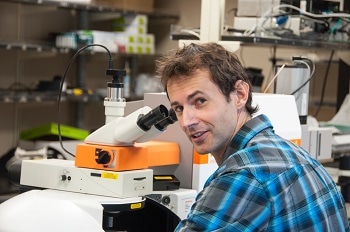The Irving K Barber School of Arts and Sciences at the University of British Columbia, Canada, hosts a multidisciplinary group of physics, engineering and radiation oncology scientists.

It is interested in detecting and understanding the damage in cells and tissues caused by ionizing radiation used in cancer treatments. Currently the radiation dose a patient receives is prescribed based on population averages and does not take the individual patient’s radio sensitivity into account. The ultimate aim of the group is to help personalise prescriptions based on an individual’s response to radiation.
In some cases, it is possible to use Raman spectroscopic techniques to detect radiation damage in patients. The group is conducting research to find out if it is possible to make an early detection tool based on Raman spectroscopy, either prior to first treatment or within the first few fractions of treatment.
Associate Professor Andrew Jirasek is a physicist by training who has specialised in accurately measuring radiation treatments for cancer patients. Together with his colleagues, Dr. Jirasek was the first to apply Raman spectroscopy to look at the unique cellular changes that occur following radiation.
This is a very powerful technique. We can record and analyse information about how the molecules and cellular constituents change throughout treatment.
Associate Professor Andrew Jirasek
Dosage can then be adjusted to be more precise and targeted.
Previously, the only outcome of treatment was disease status; for example, tumour size. Our hope is that Raman analysis will provide accurate treatment evaluation sooner. Like many other diseases, timing with cancer treatment is everything. The sooner successful therapy is implemented, the better for the patient.
Associate Professor Andrew Jirasek
After conducting cell and animal model experiments, the group is now about to test the system on prostate cancer patients.
Describing the choice of the Renishaw inVia Raman microscope for this work, Dr. Jirasek said, “We chose the inVia for multiple reasons. The system delivers excellent Raman sensitivity and throughput. It also offers us high potential for automation. Because the system is used by multiple groups and types of users, ease of use is important to maximise our ‘up time’. With several users not being experts in Raman, we have appreciated the excellent customer service support we have had from Renishaw.”
Dr. Jirasek’s work has been well reported and has recently appeared in several publications as well as presentations at conferences. Notable among these include ‘A Raman spectroscopic study of cell response to clinical doses of ionizing radiation’1 and ‘Raman spectroscopy identifies radiation response in human non-small cell lung cancer xenografts’2. Full details of this research program and publications may be viewed at Dr. Jirasek’s homepage: http://medicalphysics.ok.ubc.ca/faculty/jirasek.html
Please visit www.renishaw.com/bio for further details on how Renishaw’s inVia confocal Raman microscope is being used in the life sciences.